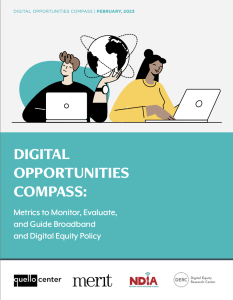DIGITAL OPPORTUNITIES COMPASS: METRICS TO MONITOR, EVALUATE, AND GUIDE BROADBAND AND DIGITAL EQUITY POLICY
 The Infrastructure Investment and Jobs Act of 2021 (IIJA) and the Digital Equity Act of 2021 (DEA) establish a broad framework and significant funding to advance broadband connectivity and digital equity. Both Acts recognize that closing the broadband access and device gaps are necessary first steps toward digital equity. To fully realize the full benefits of digital technology for individuals, communities, and society at large additional efforts are needed.
The Infrastructure Investment and Jobs Act of 2021 (IIJA) and the Digital Equity Act of 2021 (DEA) establish a broad framework and significant funding to advance broadband connectivity and digital equity. Both Acts recognize that closing the broadband access and device gaps are necessary first steps toward digital equity. To fully realize the full benefits of digital technology for individuals, communities, and society at large additional efforts are needed.
The Digital Equity Act assumes that affordable robust broadband service, Internet-enabled devices that meet user needs, applications and online content, access to digital literacy training, quality technical support, and measures to ensure privacy and cybersecurity are identified as six stepping stones toward digital equity. Both the IIJA and the DEA also establish requirements to monitor the effectiveness of programs. Specifically, they require the tracking of measurable outcomes in accordance with the six stepping stones. IIJA also requires an assessment of how the measures based on the various funding programs relate to broader community outcomes.
Doing this work well requires complementing the framework established in IIJA and DEA with additional insights from what we know about how broadband enables social, community, and economic development. With tremendous effort, states are developing a clear understanding of the current availability, quality, and affordability of broadband. Many realize that pursuing a longer-term digital equity strategy requires going beyond the mapping of availability, access, and access quality. However, there is less clarity on which other factors are relevant and should be considered when seeking to maximize the benefits of high-speed connectivity for community and economic development.
The Digital Opportunities Compass offers a framework to assist in the development of state plans that meet the reporting and assessment requirements of IIJA and DEA but go beyond access and affordability to fully harness the benefits of digital technology. As communities and states develop plans to improve digital equity, it is important to establish a shared framework to establish goals and priorities, to identify opportunities, and monitor progress toward these goals.
